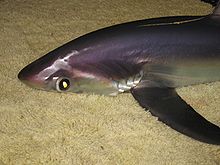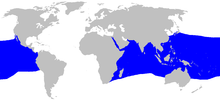Pacific thresher shark
| Pacific thresher shark | ||||||||||||
|---|---|---|---|---|---|---|---|---|---|---|---|---|

Pacific thresher shark ( Alopias pelagicus ) |
||||||||||||
| Systematics | ||||||||||||
|
||||||||||||
| Scientific name | ||||||||||||
| Alopias pelagicus | ||||||||||||
| Nakamura , 1935 |
The Pacific thresher ( Alopias pelagicus ) is one of three species of fox sharks (Alopiidae). It is distributed throughout the subtropical to tropical areas of the Pacific and Indian Oceans .
Appearance and characteristics
The Pacific thresher shark is a large shark with a maximum body length of about 365 cm. It has a dark blue to blue-violet color on the back without any noticeable markings and a white color on the abdomen, which does not, however, extend beyond the pelvic fins.
The shark has a conical, rounded snout and, compared to other thresher sharks, relatively small eyes. The caudal fin is very large and the upper caudal lobe has a length that almost corresponds to that of the rest of the body. It has a small anal fin and two dorsal fins . The first dorsal fin is significantly larger than the second and lies behind the pectoral fins. The pectoral fins are relatively large and do not end pointy as in the common thresher shark ( A. vulpinus ). Like all species of the genus, the animals have five gill slits and no injection hole .
Way of life
The Pacific thresher is an offshore species and has been relatively poorly researched. It lives in water depths from the surface of the sea to a depth of 150 m and predatory feeds on various bony fish .
Reproduction
Like other species of mackerel shark, it is viviparous and does not form a placenta ( aplacental viviparous ). The females get 2 young per litter, a uterine cannibalism is suspected in this species. The young sharks have a size of about 130 to 160 centimeters. The animals reach sexual maturity at a length of about 250 to 300 cm.
distribution
The Pacific thresher shark is found throughout the subtropical to tropical areas of the Pacific and Indian Oceans . It occurs accordingly from the east coast of Africa, the South Asian coastal areas and northern Australia to the west coasts of North, Central and South America and in the area of the offshore islands. However, it has its main distribution in the high seas.
literature
- Leonard Compagno , Marc Dando, Sarah Fowler: Sharks of the World . Princeton University Press , Princeton and Oxford 2005, ISBN 978-0-691-12072-0 , p. 179.
Web links
- Alopias pelagicus onthe IUCN 2013 Red List of Threatened Species . Posted by: Reardon, M., Márquez, F., Trejo, T. & Clarke, SC, 2004. Retrieved November 6, 2013.
- Species portrait on hai.ch
- Pelagic thresher on Fishbase.org (English)


